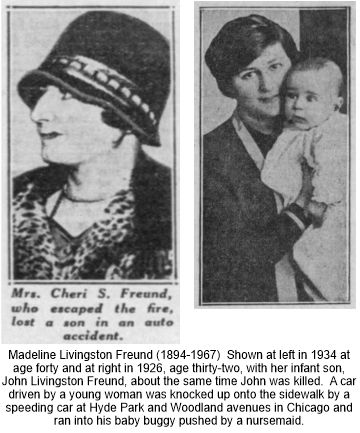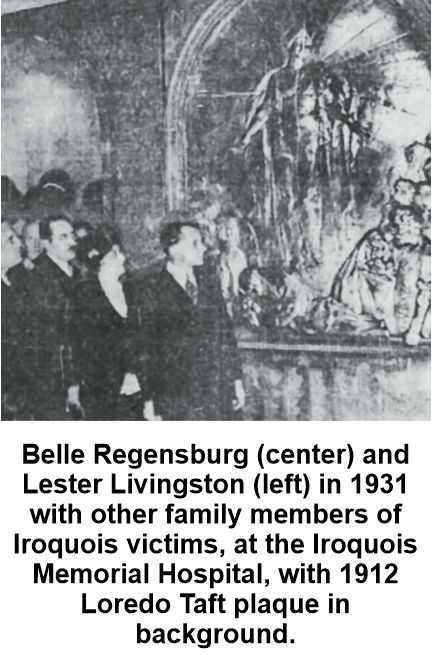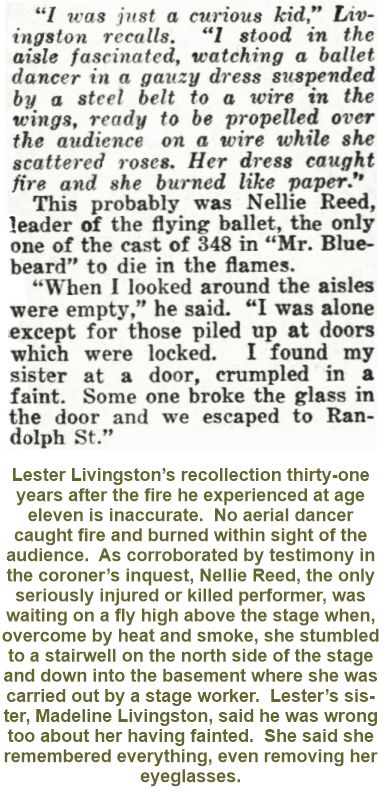|
The cousins were the children of three Straus
children, Sarah, Isabelle, and Simon, their
grandparents the widowed Madeline Goldsmith Straus
(1840–1917) and late Frederick W. Straus
(1833–1890).
The Livingstons
Lester W. Livingston and Madeline Livingston were
the children of Indiana natives Maxwell M.
Livingston (1863–1927) and Sarah Straus Livingston
(1868–1954) of South Bend, Indiana, where they lived
at 424 N. Michigan. A third sibling, Fredrick
Livingston (1898–1983), was only five and did not
attend Mr. Bluebeard.
Helen Cora Moran, nicknamed Nellie, Madeline's and
Lester's governess, in later years described herself
as their kindergarten teacher, though at eleven and
seven, they were too old for that. She was the
daughter of Thomas J. and Elizabeth O'Conner Moran.
When the fire broke out, she grabbed the youngest of
the children, five-year-old Louise Straus, and began
jumping over the backs of seats to escape. Madeline
saved her lace collar, but the fire singed their
hair.
Max Livingston operated a clothing store in South
Bend in 1903 but later moved to Chicago and worked
as an insurance agent. The family donated a library
to the Northern Indiana Orphans home at Logan and
Lincoln Way in Mishawaka, Indiana,▼2
in appreciation
for their escape and in memory of Iroquois Theater
fire victims, including their Regensburg cousins.
Max Livingston was a member of the home's Building
Committee. In the years after the fire, Madeline
Livingston married Cheri Sourdis Freund and had
three children, of which two survived to adulthood
(see below). Lester married Edna May and had one
child.
Madeline's and Lester's governess, Nellie Moran,
married in 1908 to a fellow with her same last name.
They went on to have two children. In 1934 she spoke
of her experience at the Iroquois. "I'm
sure I was the first person in the audience to see a
wisp of smoke. I was watching a bald-headed man just
in front of me, in the first row, who was watching a
chorus girl in the wings. I was so disgusted with
him I looked to see what he was looking at. He was
too interested in the girl to see the smoke, so I
saw it first." Nellie
would also survive the 1906 San Francisco
earthquake. She said they were similar in that both
began with a rumble that then became a swish.
The Straus's (sometimes spelled Strouse)
Madeline and Louise were the children of mortgage
banker Simon W. Straus (1866–1930) and Hattie Klee
Straus (1871–1966). Hattie was pregnant for their
third child at the time of the Iroquois fire. Adelle
was a former student at St. Mary's Academy in South
Bend. Both were regular visitors at the Livingston
home.
In the years after the fire, Madeline Straus
married twice and had two children. Louise also
married twice but did not have children. Simon
Straus was very successful in banking and
hotels, at his death leaving a large inheritance
to his family members. An anonymous $25,000
donation was made to the Iroquois Theater
memorial society that helped put the
Iroquois Memorial Hospital building fund over the top.
Simon's brother-in-law, Samuel Regensburg
(right), was an officer in the organization at the
time. Simon is on my shortlist of benefactor
possibilities.

|

|
The Regensburgs
Adelle Adele "Addie" Regensburg and her sister,
Hazel Regensburg were the children of Samuel H.
Regensburg (1860–1922) and Isabelle Belle Straus
Regensburg (1865–1949).▼3
Adele was a student at St.
Mary's College in South Bend, home for the Christmas
holidays.
Samuel and Belle Regensburg had married in 1886.
Like his father before him, Henry L. Regensburg,
Samuel worked as a grocer in Chicago. Henry had lost
his first grocery during the 1871 Great Chicago
fire. In 1903 the Regensburg family lived at 3440
Michigan Avenue in Chicago.
Both girls' bodies were found at Rolston's
Undertaking. At their funeral, one room in the
family's home contained their caskets while guests
gathered in an adjoining room. Many classmates and
family were present. The girls wore white dresses
they'd worn a few days prior at a party. The detail
about their dresses tells us they died of
suffocation and were not badly trampled or burned,
allowing open caskets. The service had to be short,
Dr. Emil G. Hirsch advised, because he had four
other funerals to do that day for Iroquois Theater
victims. He went from the Regensburg's to the
Zeisler's.
Their floral-covered white caskets were born in a
white carriage pulled by white horses to a
Northwestern train probably bound for the Rose Hill
cemetery.
In later years Samuel and Belle became involved in
the Iroquois Memorial Association, Sam serving as
president of the group in 1918.


|
|
Discrepancies and addendum
There was another party named Livingston at the
Iroquois Theater, but I've not found evidence of a
familial relationship between them. Jean and Daisy
Livingston's story is
here.
1. The name was sometimes spelled, Livingstone.
2. The Children's Aid Society of Indiana operated the
orphanage in the early 1900s. The Women's Christian
Temperance Union founded the facility in 1882. It
evolved into today's
Family & Children's Center.
Though located in Mishawaka, IN, in the early 1900s,
it was commonly referred to as the "South Bend
Orphan Home." In addition to Max Livingston,
benefactors of the home included Samuel Leeper, J.
M. Studebaker, and other prominent members of the
community.
A 1907 description of Orphanage history.
3. Belle may have been at the Iroquois with her
daughters and survived. Some newspapers reported a
"B. Regensburg" among the victims, but the Chicago
coroner's office did not issue a burial permit for a
third Regensburg, and stories about the Regensburgs
in later years did not mention a third victim.
Several newspapers inaccurately reported that Adele
was the younger of the sisters, but the information
the family reported to the 1900 U.S. Census
enumerator, supported by the Cook County birth
certificate index, makes Adelle the eldest and Hazel
the youngest.
|
